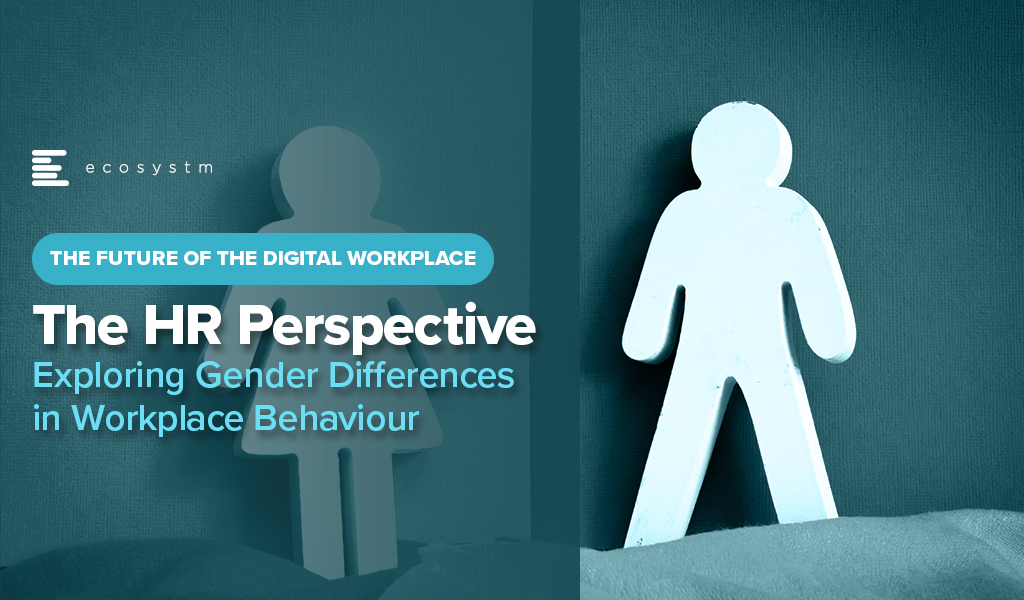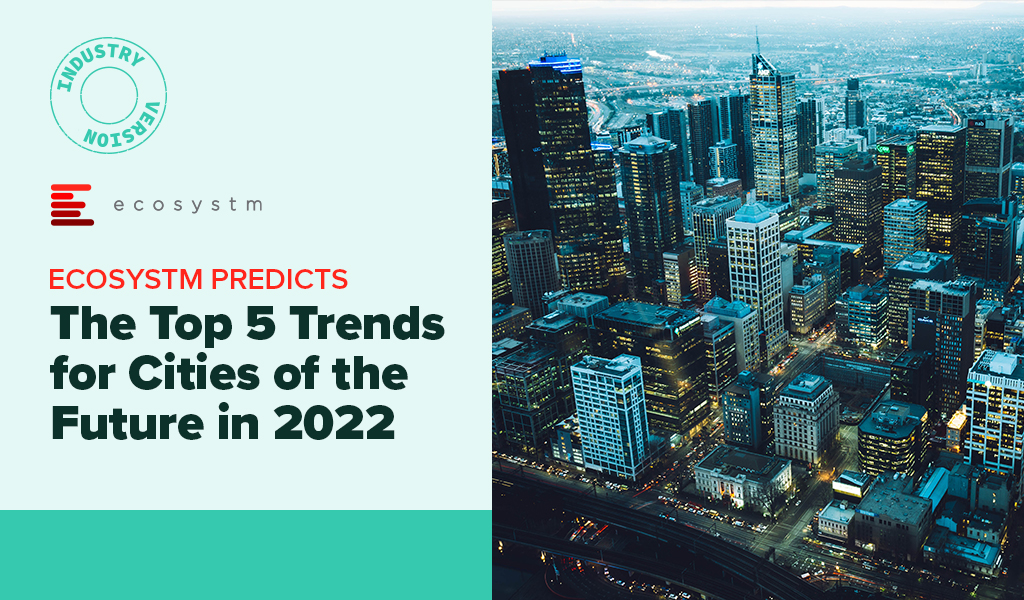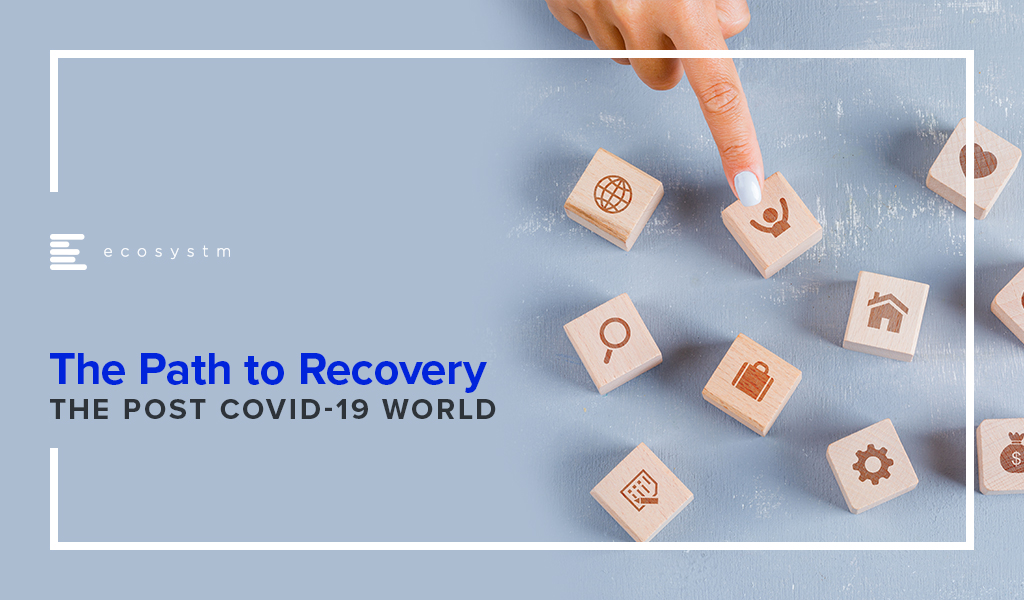It seems for many employees, the benefits of working from home or even adopting a hybrid model are a thing of the past. Employees are returning to the grind of long commutes and losing hours in transit. What is driving this shift in sentiment? CEOs, who once rooted for remote work, have undergone a change of heart – many say that remote work hampers their ability to innovate.
That may not be the real reason, however. There is a good chance that the CEO and/or other managers feel they have lost control or visibility over their employees. Returning to a more traditional management approach, where everyone is within direct sight, might seem like a simpler solution.
The Myths of Workplace Innovation
I find it ironic that organisations say they want employees to come into the office because they cannot innovate at the same rate. What the last few years have demonstrated – and quite conclusively – is that employees can innovate wherever they are, if they are driven to it and have the right tools. So, organisations need to evaluate whether they have innovated on and evolved their hybrid and remote work solutions effectively, to continue to support hybrid work – and innovation.
What is confusing about this stance that many organisations are taking, is that when an organisation has multiple offices, they are effectively a hybrid business – they have had people working from different locations, but have never felt the need to get all their staff together for 3-5 days every week for organisation-wide innovation that is suddenly so important today.
The CEO of a tech research firm once said – the office used to be considered the place to get together to use the tools we need to innovate; but the reality is that the office is just one of the tools that businesses have, to drive their organisation forward. Ironically, this same CEO has recently called everyone back into the office 3 days a week!
Is Remote Work the Next Step in Employee Rights?
It has become clear that remote and hybrid work is the next step in employees getting greater rights. Many organisations fought against the five-day work weeks, claiming they wouldn’t make as much money as they did when employees worked whenever they were told. They fought against the 40-hour work week (in France some fought against the 35-hour work week!) They fight against the introduction of new public holidays, against increases to the minimum wages, against paid parental leave.
Some industries, companies, unions, and countries are looking to (or already have) formalised hybrid and remote work in their policies and regulations. More unions and businesses will do this – and employees will have choice.
People will have the option to work for an employer who wants their employees to come into the office – or work for someone else. And this will depend on preferences and working styles – some employees enjoy the time spent away from home and like the social nature of office environments. But many also like the extra time, money, and flexibility that remote work allows.
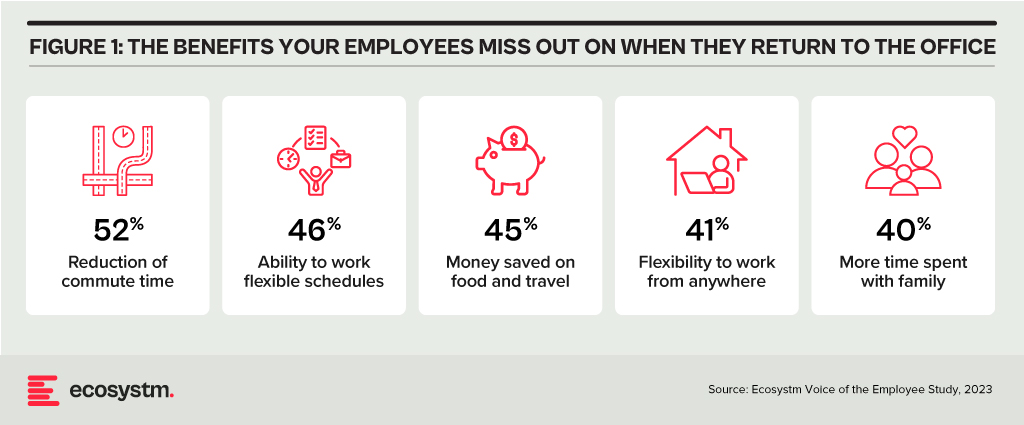
There might be many reasons why leadership teams would want employees to come into the office – and establishing and maintaining a common corporate culture would be a leading reason. But what they need to do is stop pretending it is about “innovation”. Innovation is possible while working remotely, as it is when working from separate offices or even different floors within the same building.
Evolving Employee Experience & Collaboration Needs
Organisations today face a challenge – and it is not the inability to innovate in a hybrid work environment! It is in their ability to deliver the employee experience that their employees want. This is more challenging now because there are more preferences, options, and technologies available. But it is established that organisations need to continue to evolve their employee experience.
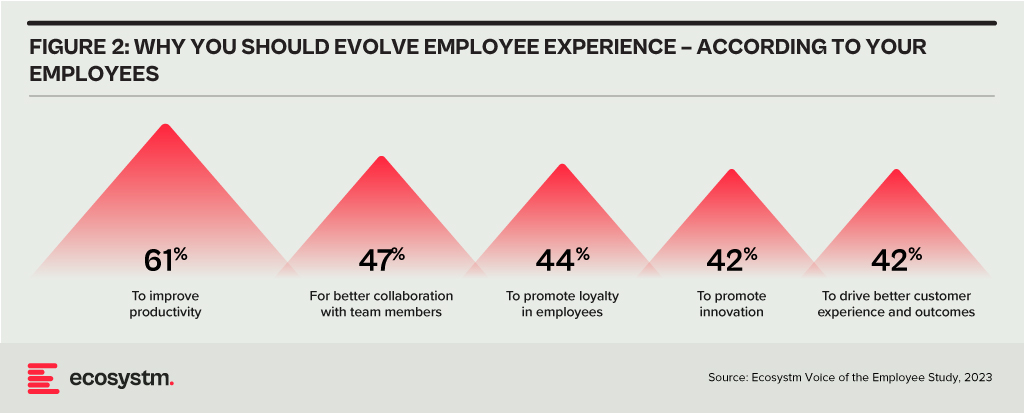
Technology does and will continue to play an important role in keeping our employees connected and productive. AI – such as Microsoft Copilot – will continue to improve our productivity. But the management needs to evolve with the technology. If the senior management feels that connecting people will help to solve the current growth challenges in the business, then it becomes the role of managers to better connect people – not just teams in offices, but virtual teams across the entire organisation.
Organisations that have focused their energies on connecting their employees better, regardless of their location (such as REA in Australia), find that productivity and innovation rates are better than when people are physically together. What do they do differently?
- Managers find their roles have moved from supporting individual employees to connecting employees
- Documentation of progress and challenges means that everyone knows where to focus their energies
- Managed virtual (and in-person) meetings mean that everyone has a voice and gets to contribute (not the loudest, most talkative or most senior person)
Remote and hybrid workers are often well-positioned to come up with new and innovative ideas. Senior management can encourage innovation and risk-taking by creating a safe environment for employees to share their ideas and by providing them with the resources they need to develop and implement their ideas. Sometimes these resources are in an office – but they don’t have to be. Manufacturers are quickly moving to complete digital development, prototyping, and testing of their new and improved products and services. Digital is often faster, better, and more innovative than physical – but employees need to be allowed to embrace these new platforms and tools to drive better organisational and customer outcomes.
What the pandemic has taught us is that people are good at solving problems; they are good at innovating irrespective of whether their managers are watching or not.

HR has the biggest role to play in shaping the employee experience that an organisation provides – and it cannot achieve this without a close alliance with the Tech/Digital Team. While this synergy is missing in most organisations, HR teams need to step up by listening to what their employees are saying. Having an understanding of how perspectives change based on employees’ demographic profiles, can help HR teams immensely.

The role of HR has evolved
The corporate challenge of managing skills shortages, employer of choice strategies, and flexible work programs have long existed. It’s just that, like most strategic imperatives, they have been optional, even for the most competitive businesses.
The Ecosystm Voice of the Employee Study highlights that the current resignation pandemic is supercharging a skills famine for many firms. But with almost all attention from the Great Resignation still focused on employee experience (EX), deep consideration must be given to efficiently and effectively navigating the extreme workload now facing internal HR functions.
Recruiting, inducting, onboarding, training, and cross-boarding new staff, while exiting and off-boarding old staff, often remotely and at high volume, will see shadow-HR technologies and practices bleed out of People and Capability departments as companies scramble to reset demand.
Regardless of industry, every company’s core business just became HR!

The need for Personalised Employee Experience
The industry has been talking about the need to create personalised customer experience (CX) for a while now – we should talk about creating personalised EX now.
Given the changes and challenges that your employees have faced over the last two years, they have developed some strong work preferences. HR has the biggest role to play in shaping the EX your organisation provides – and it cannot achieve this without a close alliance with the Tech/Digital Team.
According to the Ecosystm Voice of Employee Study, 50% of your employees believe that improved EX leads to better CX.
It may not be possible to cater to the needs of every individual employee. But taking into consideration some of the differences – whether based on role, age, gender, family status and so many other factors that make up an individual – will help you shape your organisation’s Digital Workplace strategy and offer a more personalised EX.
Here are 5 gender differences in workplace behaviour according to the Ecosystm Voice of the Employee Study.
- Women are more likely to change jobs in 2022
- The assumption that women prefer to work from home is wrong
- More men prefer 5-Day work weeks
- The challenges of working from home might be very different
- Women and men have different collaboration styles
Read on for more insights.
Download “The Future of the Digital Workplace: The HR Perspective” slides as a PDF

Cities worldwide have been facing unexpected challenges since 2020 – and 2022 will see them continue to struggle with the after-effects of COVID-19. However, there is one thing that governments have learnt during this ongoing crisis – technology is not the only aspect of a Cities of the Future initiative. Besides technology, Cities of the Future will start revisiting organisational and institutional structures, prioritise goals, and design and deploy an architecture with data as its foundation.
Cities of the Future will focus on being:
- Safe. Driven by the ongoing healthcare crisis
- Secure. Driven by the multiple cyber attacks on critical infrastructure
- Sustainable. Driven by citizen consciousness and global efforts such as the COP26
- Smart. Driven by the need to be agile to face future uncertainties
Read on to find out what Ecosystm Advisors, Peter Carr, Randeep Sudan, Sash Mukherjee and Tim Sheedy think will be the leading Cities of the Future trends for 2022.
Click here to download Ecosystm Predicts: The Top 5 Trends for Cities of the Future in 2022

The term “intranet” won’t die. It should. I don’t think I have ever seen a good intranet in 24 years since I first started writing about business intranets in 1997 (yes – by writing about this market I was a part of the problem!). I’d even argue that there is no such concept as a “good intranet” – as it is an inherently flawed idea. An intranet effectively tries to bring together all the stuff that employees don’t access or don’t want to access and puts it somewhere that employees might actually use.
Intranets don’t help employees do their jobs
Why don’t we access these systems? Because they are generally not “core” to our jobs. Employees will find and access the systems and applications that are core to getting their jobs done – even if they are terrible to use (even in this “designed for humans, SaaS-world” there are still plenty of core systems that are terrible to use). Some companies try to integrate their intranet and core applications; making employees access the intranet to login to their essential apps. This might make life easier for IT responsible for deploying, managing and securing the applications. It also excites HR as they hope that along the way to accessing these systems, a “schmear” of company culture or information might rub off on them. But many employees quickly work out ways around these systems by bookmarking sites or using dedicated applications.
One of the reasons that company intranets are generally so poor is because they don’t actually help people do their job. There are often no guided processes or checklists to ensure follow through on tasks. Remember how many salespeople didn’t (or still don’t) use the CRM system because it didn’t help them actually sell? Well, intranets suffer from the same problem.
Some software providers looked to solve this problem by bringing the company intranet and core application together into a single interface. Salesforce has limited success with Chatter – but many users of Chatter spent much of their energy telling employees they “weren’t using Chatter the right way” – which sounds awfully like a design problem, not a user one.
Now is a good time to review your company intranet
Why now? Because the big collaboration players (Microsoft in particular) are improving their offerings in this space, creating partnerships, and painting a vision of a world where employees might actually WANT to access company intranets.
Which brings me to Microsoft Viva. We wrote about Viva when it was initially launched as a concept and businesses (and more importantly, their employees) can now experience the capabilities. Viva helps resolve some of the challenges with business intranets:
- It makes some of the collaboration systems more usable and insightful
- It actually provides outcomes for employees (through the learning module in particular)
- It integrates with existing processes and exposes these application-centric processes through Teams
At the same time, it is trying to be a “cultural change agent” by having a single place to go to view company news and announcements. This is similar to many company intranets, and like many of them, is likely to be an abandoned sideshow – the only time many employees visit it will be when they are forced to – like when the CEO sends an all-company email saying that there is an announcement on the company intranet that everyone needs to see. Which is the digital equivalent of posting you a letter to inform you that you have an email!
The challenge for Viva is that employees need to be using Teams to get the most out of it – and I don’t just mean “using Teams for chat and calling” but using the collaboration elements effectively – ALL the time. And the challenge with this is that (a) many employees don’t EVER use these features of Teams (or use them sporadically), and (b) some companies (and teams within companies) have multiple platforms for collaboration and sharing (Slack, Trello, Basecamp, Jira etc).
But either way, Viva looks like a positive step forward for collaboration – and more importantly, it gives businesses some guidelines on how to improve their existing intranet.

How to Make your Intranet work?
Integrate the work that people have KPIs on, with collaboration and intranet systems
Design processes so the intranet makes it EASIER for people to do their jobs – by removing unnecessary handing of information, copying and pasting, multiple levels of authentication and moving between many applications or screens. Leave requests or approving invoices have already been integrated into email – so managers can click a button in the email to send the approval. But what if there were a page on the intranet where all the leave requests or approvals for funding or payment were in a single spot? What if the system provided insight around these requests (such as Mary Singh only has 1 day leave left, or Company ABC takes 90 days to pay on average)? And if all leave requests could be approved with a single click, it actually makes the employees life easier.
Build processes into the systems to solve employee pain points
Many intranets are ostensibly used for helping employees find each other or find experts on specific topics. But they don’t guide this process – they just say “there’s lots of information here – use the search tool and good luck!”. Design guided processes for outcomes people actually want to achieve. Survey your employees to find out what they’d like the intranet to help them achieve – and build some employee journey maps across various roles to understand the challenges and pain points. If it makes sense, use the intranet to help resolve those pain points.
Make your existing tools more powerful and easier to use
Your employees generally want to collaborate. Don’t get me wrong – many don’t wake up each morning thinking that they’d love to share some documents with unknown team members today – but they do want to work together more easily than they do today. So take a look at what stops them from achieving this and look to solve those problems by making existing tools more powerful and easier to use. Adding analytics helps employees and their managers better manage their time and their interactions. Automating file sharing and discovery will help employees find the information they need without adding additional work for the content creator.
Businesses need to think of their intranets as “places to get things done”
Too many intranets seem to be designed for 4pm on Friday afternoon versus 9am Monday morning. And if this is yours, then don’t be surprised that employees don’t use it that often or give it little time. The more you can use an intranet to make employees lives easier, the more likely that you will be creating a resource which improves the productivity and happiness of the employees you serve.

An Update (1 October 2021): This acquisition did not go through even after the boards of directors of both companies had approved it. It was voted down by Five9 shareholders, citing growth and valuation concerns. This is an unusual example of an acquisition not going through because of unwillingness of one of the companies. In recent times, regulators have stopped some acquisitions. Incidentally, there were some concerns raised by the by Federal Communications Commission (FCC) as Zoom is based in US. but has product development operations in China.
The partnership arrangement between the two companies will continue including support for integrations between their respective Unified Communications as a Service (UCaaS) and Contact Centre as a Service (CCaaS) solutions and joint go-to-market initiatives.
Zoom has announced their intention to acquire cloud contact centre service provider Five9 in an all-stock deal for about USD 14.7 Billion. This is Zoom’s largest-ever acquisition as the communications platform continues to expand their services and launch new products. The deal is expected to be completed in the first half of 2022 and Five9 will be an operating unit of Zoom.
The last year has seen Zoom scaling up their product offerings, including cloud calling solution – Zoom Phone, conference hosting solution – Zoom Rooms, and applications and productivity tools – Zoom Apps and Zoom Marketplace. Zoom also acquired real-time translation startup Kites GmbH to offer multi-language translation capabilities, and Keybase – a secure messaging and file-sharing service to build end-to-end encryption for its video conferencing platform.
Ecosystm Analysts share their thoughts on Zoom’s strategy and roadmap, how Five9 will augment Zoom’s capabilities, and the impact the acquisition will have on Zoom’s competitors and the market.

Why Contact Centre?
Ecosystm Principal Advisor Tim Sheedy says, “Zoom is moving beyond its period of ‘organic hypergrowth’ brought on by the pandemic. While the paying customer base for their core video collaboration service will continue to grow, growth rates are likely to begin to track the market. To grow beyond market rates, Zoom needs to move into new markets – through product development or acquisition.”
Talking about the importance of voice services, Sheedy adds, “Voice services are an obvious adjacent market to help drive growth, and Zoom already has seen some success with their Zoom phone service and associated devices – in fact, they already have 1.5 million users. The Five9 acquisition gives the company a stronger and deeper capability in the voice sector; buying them a significant chunk of the voice services in business – the contact centre. In many businesses, the contact centre already accounts for over 50% of their voice minute usage, so winning this space will go a long way towards winning the overall voice and collaboration supplier in enterprises.”
Ecosystm Principal Advisor Audrey William predicts exciting times ahead for Zoom. “With Zoom already having a platform for video, then bringing voice into that equation and now a contact centre solution, makes them take on their competitors in an all-native cloud stack. There is a still a large installed base of on-prem UC customers and with Zoom seeing success with Zoom phones in the short time frame since its launch, this is where this will get exciting for Zoom. The telephony piece is still important in the race to simplify how we work, communicate, and collaborate today. It is that same voice/telephony discussion that can lead to a routing discussion, which then leads to a contact centre discussion.”
Ecosystm research shows that 54% of organisations are challenged in their customer experience delivery because of integration issues between multiple platforms. William sees this as an opportunity for Zoom. “The use cases to integrate workflows into the video environment is going to be important for Zoom. Video is now being used to solve customer service issues like letting the agents take over the screen to see how to help solve the customer problem immediately by using video and contact centre applications. The ability to bring this natively together will be very powerful. Zoom is investing heavily into apps and working to partner with ISVs who can develop workflows suitable for easy customer communication in specific industries such as Healthcare and Financial Services.”
Why Five9?
Five9 is considered a pioneer in cloud contact centre solutions and owns a comprehensive suite of applications for contact centre delivery and customer management operations across different channels. Five9 has made several acquisitions and enhancements to their CCaaS solution in recent years to make their stack more complete with richer AI offerings. They include Inference Solutions to offer their customers a Conversational AI solution and Whendu’s iPaaS platform which provides a no-code, visual application workflow tool.
William says, “More contact centres want to do away with monolithic IVR systems that confuse customers with too many long menus. The Agent Assist solutions are also gaining importance especially in the hybrid work model where agents face challenges working in isolation and not being on a floor with their colleagues and managers.”
Five9 has acquired a cloud workforce optimisation provider Virtual Observer. “So, we are not looking at just a basic level contact centre solution but an offering with important capabilities demanded by customers,” says William. “During the investor call this week, Zoom’s Eric Yuan and Rowan Trollope made it clear that they have been listening to customer feedback on how effective it would be to have a single platform that can accommodate UC and contact centres in the cloud. Zoom also sees Five9 as a good fit culturally; and their goal now will be to disrupt all legacy systems with cloud-native communications.”

What lies ahead?
William thinks that Zoom’s competitors will be watching this integration closely, especially those that lack an all-in-one native cloud UCaaS and CCaaS stack. “However, some of Zoom’s competitors have an established base of large enterprise customers and have done well to grow revenues and defend their base over the years. Working with in-country partners and ISVs will be critical for Zoom’s growth across regions.”
Sheedy thinks that the most important takeaway from this acquisition is not that Zoom is moving into the contact centre space. “It is that Zoom realises they have a “once in a generation” opportunity to grow beyond their core and cement their position as a supplier of collaboration and communication services – and that they are willing to flex their balance sheet and share price to create their future. The competition – from Microsoft in particular – will be strong. Google, AWS, Salesforce, and Facebook are also making a play for this market. Zoom has found themselves in their current position of strength due to good luck and good timing – and they appear to be telling the market that they aren’t going to give up their leadership without a significant battle.”
“Enterprises will be the true winners in this battle – with better, more integrated, lower cost and easier to implement communications and collaboration solutions for their employees and customers,” adds Sheedy.

Juniper Networks has entered into an agreement to acquire Massachusetts-based 128 Technology for USD 450 million that will enhance its AI-driven enterprise networking portfolio. The deal is expected to close by the end of 2020. The combined portfolio of 128 Technology’s Session Smart™ networking and Juniper’s Mist AI platform will bolster Juniper’s AI expertise in SD-WAN technology.
Ecosystm Principal Advisor, Ashok Kumar says, “Juniper Networks has been a major player in enterprise networking from the core to the edge of the network with SD-WAN, WLAN, and AI-driven applications aware network products. Juniper had strengthened their enterprise networks portfolio with the acquisition of WLAN vendor Mist Systems in 2019 which provided cloud-based management and an AI engine. With Juniper’s acquisition of 128 Technology the network transformation process in the industry will continue.”
The platform created by 128 Technology bases decisions on real-time sessions instead of legacy static systems and networking approaches. The newer system created through this by Juniper will use AI to automate sessions and policies for a full AI-driven WAN operation – from initial configuration to customisable actions across various levels, and AI-driven support.
In addition to this, the automation is expected to reduce overheads, minimise IT costs and deliver better client and user-experience through automated network optimised for client-to-cloud. The two companies also aim to optimise the network and user experiences for voice, 5G and collaboration. Juniper continues to evolve the enterprise networking portfolio adding to the acquisition of WLAN start up Mist Systems for USD 405 million last year. Juniper’s AI -driven SD-WAN and networking products and services for enterprises and end-users is a step towards smart LAN and WAN environments.
A recent study on The Future of the Secure Office Anywhere, conducted by Ecosystm on behalf of Asavie found that 56% of global organisations are looking to improve employee experience, as they look beyond the COVID-19 crisis. The feedback from over 1,000 business and technology leaders globally, also finds that 55% of the organisations are also focused on digital transformation. This will require a re-evaluation of enterprise network solutions, to give employees seamless access to company resources as they continue to work remotely.
“Enterprise communications is being transformed to a user-centric, session-oriented distributed model from a legacy network-oriented centralised WAN model. In the new remote working environment of Office Anywhere, the traditional use of VPN in combination with first-generation SD-WAN will become an impediment going forward. Enterprises will need to re-design networks to address each end-user’s unique needs and their access to applications and all business resources as though they were a Branch of One.”
I recently came across an article which makes 7 predictions for a post COVID world. Upon reflection, I agree with the predictions to varying degrees and decided to comment further.
First, let me share a couple of general observations. Currently, we are still in the eye of the storm. Many are unable to see any light at the end of the tunnel. There is quite a bit of negative sentiments, and some fail to see that the situation will ever improve. I am sure similar thoughts occurred during other crises: the 1918 Pandemic (Spanish Flu); the Great Depression of the 1930s; the Dot.com bust of 2001; SARS in 2003; and the Global Financial Crisis/Great US Recession of 2007. During each of these events, a sense of impending Armageddon came over much of the population. Certainly, in each instance, people did experience some personal and social permanent changes, with which they learned to adapt and cope. But, inevitably, the world did go on and Armageddon did not occur.
One of the basic truths I believe, is that humans require and crave interaction with other humans. Think about the videoconferencing applications. The use of these apps grew exponentially as the main communication channel. Instead of just audio, it was audio and video. These mediums greatly assisted society in coping and adapting. Mankind, and the Natural World, will always find a way.
Here are the predictions from the article:
- Companies that traffic in digital services and e-commerce will make immediate and lasting gains
- Remote work will become the default
- Many jobs will be automated, and the rest will be made remote-capable
- Telemedicine will become the new normal, signaling an explosion in med-tech innovation
- The nationwide student debt crisis will finally abate as higher education begins to move online
- Goods and people will move less often and less freely across national and regional borders
- After an initial wave of isolationism, multilateral cooperation may flourish
I very much agree with the author’s first prediction. This one is fairly obvious, as it has proven true throughout the crisis with providers such as Amazon, Zoom and others. It is expected to continue into the post COVID world. This is also evident from the findings of the Ecosystm research on the impacts of COVID-19. Organisations intend to continue to use digital technologies, even after the immediate crisis is over (Figure 1).
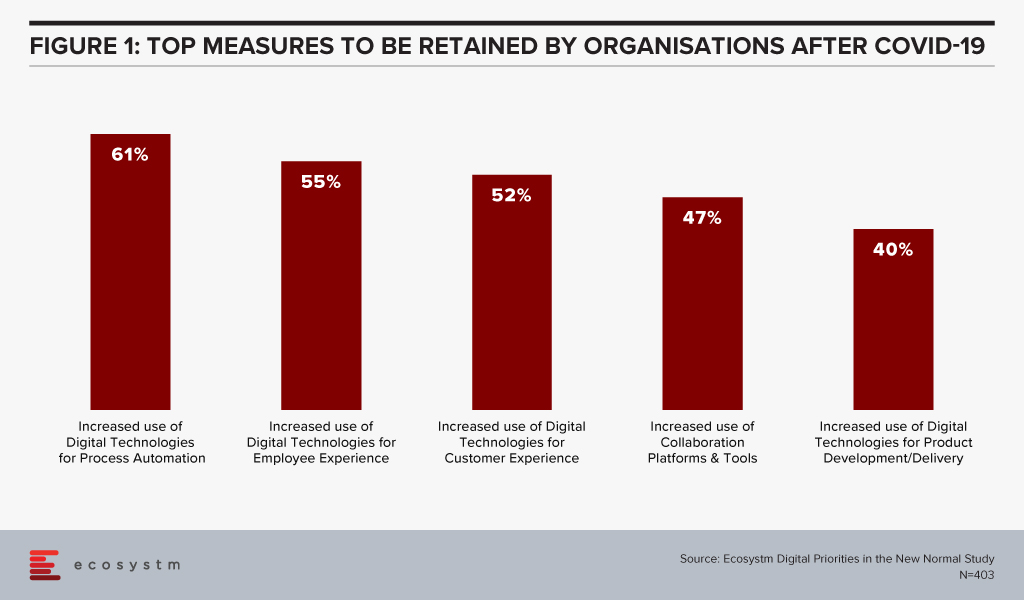
A Natural State of Equilibrium will Emerge
I believe for each of the areas described in the predictions, there will be various levels of long-term modification. None of them will return to their pre COVID-19 state, as we have all experienced going down the rabbit hole. During the pandemic, due largely to the lockdowns, the pendulum swung significantly towards one side. Many times, when people predict a new view, the current state is considered the New Normal. For me, the relevant question is: Will things stay as they are now, or will there be a new natural state of equilibrium? If so, what will it look like, in each of these areas? I don’t believe there is one answer, or one New Normal for all the dimensions being discussed. I believe a new normal state will potentially be different for each individual, each company/entity and each condition. In a post COVID-19 world there could be 50 shades of grey in each of these areas.
One of the predictions states that remote work will become the default. It must be remembered that part of work is a collaborative effort. While video conferencing has enabled collaborative efforts, the importance of the accidental interaction at the break room, printer, etc. can’t be under-estimated. It is these unscheduled interactions that enable accidental collaboration which can lead to great solutions. Thus, there will be many shades to the Future of Work – there will not be one absolute.
A similar example is a prediction for higher education. Part of the learning process a university offers is interacting with people who are not similar to your background or beliefs. That is one of the benefits of a diverse university. Similar to the corporate environment, many different types of learning environments will enable a person to gain great experiences from the time at university.
The advantage of all these alternatives will be the additional options and benefits to people post COVID compared to the pre COVID-19 world. It will present many great opportunities for entrepreneurs and innovators, as well as end-users and consumers. It will create new and iterative ‘middle spaces’. It will be possible for a David to emerge and challenge a Goliath(s).
The two Chinese characters for the word ‘crisis’ are “danger” and “opportunity”. Just as we are in a dangerous time now, it has also presented new and different opportunities. Those opportunities will continue to exist even when the danger has passed. I am also reminded of the old expression “May you live in interesting times”. It very much applies to all of us now and in the future. I wish the same for all of you.
Stay Safe. Stay Healthy. Stay Mentally Positive.

We continue to receive responses from the tech buyer community on the impact of COVID-19 on Digital Transformation initiatives, and the early business and technology measures that were implemented to combat the crisis. As the months go by, it is becoming apparent that organisations have implemented the early measures and are now looking ahead to their journey to recovery.
IT Teams realised that even if they had the right technology solutions, they were unprepared for the scale or capacity to extend these technology offerings to handle the sudden and enormous changes required to manage the crisis. Their cloud business applications, cybersecurity and collaboration solutions were simply not sufficient to meet the needs of the remote workforce. As organisations become more conscious of business continuity planning (BCP) for future eventualities, they will boost their technology capabilities, over the next 12 months.
Another area the study aims to explore is how optimistic is the business outlook, when it comes to expecting a return to normalcy. Only 3% of organisations are expecting a New Normal that is very different from where things were at the beginning of the year. About a third of organisations are expecting a return to normalcy by the end of the year, while the majority expect to recover by the middle of 2021. Also, some industries are more optimistic of a recovery than others. As an example, 35% of healthcare organisations expect a return to normalcy by the end of the year. This is a positive indicator, given that the industry has been in the forefront of the crisis, for nearly 6 months now.

More insights on the impact of the COVID-19 pandemic and technology areas that will see continued investments, as organisations get into the recovery phase, can be found in the Digital Priorities in the New Normal Study.
As organisations come to terms with the “new normal”, technology companies are presenting unique offerings to help them tide over the situation and lead them towards economic and social recovery. These companies are also leading from the front and demonstrating how to transform with agility and pace – evolving their business and delivery models.
Organisations are dependent on digital technologies more than ever before. In 2020, we have already seen unprecedented and rapid adoption of technologies such as audio and video conferencing, collaboration tools to engage with employees and clients, contactless services, and AI/automation. This will have a wider impact on the technology industry, community, and redefining the workplace of the future.
Ecosystm Principal Advisor, Tim Sheedy hosted a virtual roundtable with business leaders from some of the world’s largest technology service providers to discuss how they managed the challenges during the pandemic; and the measures they implemented to support not only their business operations and working environment, but also to help their customers negotiate these difficult times.
The Role of Technology During the COVID-19 Crisis
When the COVID-19 crisis hit, IT teams found themselves largely unprepared. Ecosystm research finds that only 9% of organisations considered their IT fully prepared for the changes that had to be implemented (Figure 1). More than a third did not have the right technology solutions and 41% were unprepared for the scale of the changes required and the capacity to extend the existing technology to meet client and employee needs. 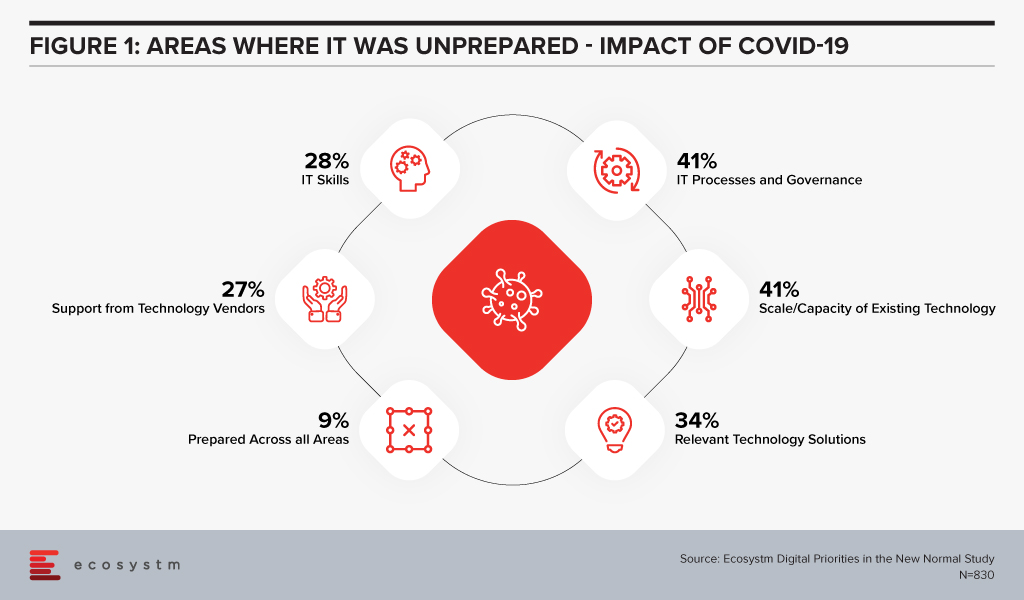
While 27% of organisations felt that they needed more support from their IT provider, further questioning reveals that only 4% switched technology providers for better support during these difficult times. Organisations are looking to their technology partners for guidance, as they negotiate the new normal.
Here are some of the discussion points that emerged in the conversation with the technology providers.
Business Continuity Planning is Still Evolving
One of the early impacts on businesses was due to their dependence on outsourced services and offshore models. Several concerns emerged – how could their provider continue to operate offsite; would they be able to access the network remotely; how should fully remote teams be managed and so on. In addition to this, there were other challenges such as supply chain disruptions and a sudden change in business. Even technology providers felt that they were navigating uncharted territory.
“Remote project delivery is not new, it’s been going on for a few years; but I think that there’s been a lot of non-believers out there. This experience has moved a lot of those non-believers to the believer category. A lot of our delivery can be done from home – think of the savings of time and money that can be realised through this.” – Andrew Campbell, Partner Asia Pacific for Talent and Transformation, IBM
Moreover, the rising workload and client expectation has led businesses to move towards exploring automation and AI.
“The thing that is changing now is, when we approach a new opportunity or an existing customer with a new requirement, we look at using automation. Typically, when you go in to design a solution you always think of the human aspect. We’re working very hard to move our thinking to automation first and then supplementing it with the human side as a backup.” – Michael Horton, Executive VP, ANZ, HCL Technologies
Data has become paramount in this time of crisis. The right use of data is helping organisations fulfil customer requirements, enhance their experience, and optimise services and products.
“Those organisations that have a good understanding of the data within their business, and how that data can be used to understand the impact on their business, are starting to have much better clarity on future requirements.” – Peter Lawther, Oceania Regional Technology Officer, Fujitsu
Organisations should take the learnings from managing this situation to keep evolving their business continuity plans – keeping in mind individual business needs and growth and business strategies.
Having the Right Infrastructure Means Employees are Productive
The lockdown and social distancing measures forced organisations to focus on the infrastructure that can support their remote and hybrid work environment.
“Before the pandemic around 20-30% of our staff logged on to a VPN, but with remote working, all of a sudden, we were at 90%.” – Lawther
The adoption of digital tools and online infrastructure led businesses to re-think how they were delivering their services. While some organisations had the tools, governance and the protocols in place, there is still a long way to go for organisations to solve their infrastructure and networking challenges.
“It gets down to the quality of the equipment that the staff use – which ranges from decent laptops, phones, and network connections. If you don’t have that now, people cannot work effectively.” – Horton
Several of these organisations, focused on ergonomics as well, when evaluating their employees’ infrastructural needs when working from home. This extra focus on infrastructural needs – with the employees firmly on their mind – ensured that there was minimal impact on delivery.
Caring for Your People is More Important than Ever
The pandemic has changed the way people work, socialise, and interact. While this appears to have become the new norm, adjusting to it can create emotional stress. Simultaneously, as organisations focus on survival and recovery, workloads have increased. Employees are working extended hours, without taking adequate hours. There is an immediate need to involve organisations’ HR practices in evaluating the emotional well-being of employees and finding better ways to engage with remote staff, to reduce stress.
“A key aspect of handling the crisis has been empathy, transparency and engagement with employees. In a business environment, we have all sorts of teams, cultures, clients, and so on. The common thread in this model is that everyone’s just become a lot friendlier, more empathic, more transparent.” – Sumit Nurpuri, COO, SE Asia Hong Kong and Taiwan, Capgemini
Organisations will have to be innovative in the way they manage these people challenges. For example, a common problem that has emerged is employees attending meetings, with interruptions from family, especially children.
“One of the things that we did as a part of our team meetings is that we assigned tasks to children at the beginning of the call and in the last few minutes, the children presented back to the teams on what they’ve been up to. It was a mechanism for us to make sure that we were involving our staff and understanding their current situation – and trying to make it as easy for them to work, as possible.” – Lawther
Taking the Opportunity to Drive Positive Outcomes
The other aspect businesses are trying to overcome is meeting the rising expectations of clients. This has led them to focus on skills training, mostly delivered through e-learning platforms. Organisations find that this has translated into increased employee performance and a future-ready workforce.
The crisis disrupted economies and societies across the globe, with business and industry coming to a standstill in most countries. Unexpected business benefits emerged from the necessity to comply with country regulations. By and large, employees have been more productive. Also, many organisations re-evaluated their commercial property requirements and many were able to reduce expenses on office rentals (for many this will not be immediate, but there is a future potentiality). Similarly, there were other areas where businesses saw reduced expenses – operational costs such as equipment maintenance and travel expenses.
“When you start global projects and global implementations, you typically do some kind of global design work and maybe fly in people from all over the world, typically to a centralised location. This has changed to virtual meetings and collaborative interactions on online global design. The amount of time and money that was saved – that would typically be spent on people traveling to manage these global design workshops – was great” – Campbell
Most organisations, across industries, will have to make considerable changes to their IT environment. The Ecosystm Digital Priorities in the New Normal study finds that 70% expect considerable to significant changes to their IT environment, going forward. Technology providers will remain a significant partner in organisations’ journey to transformation, recovery and success.




